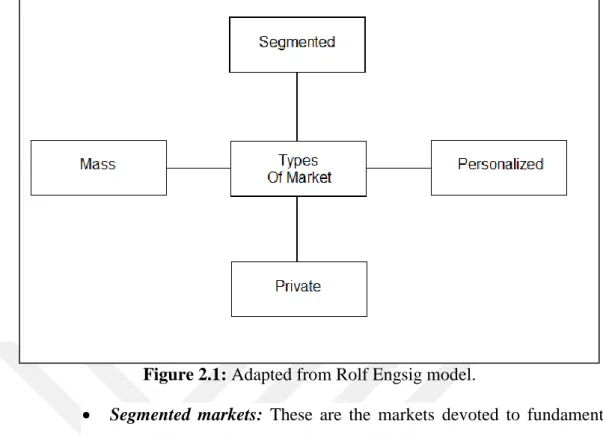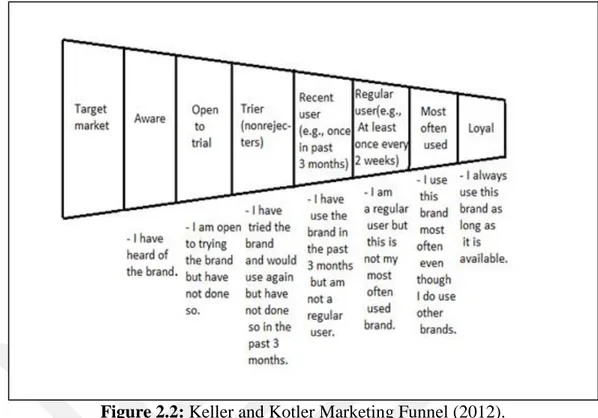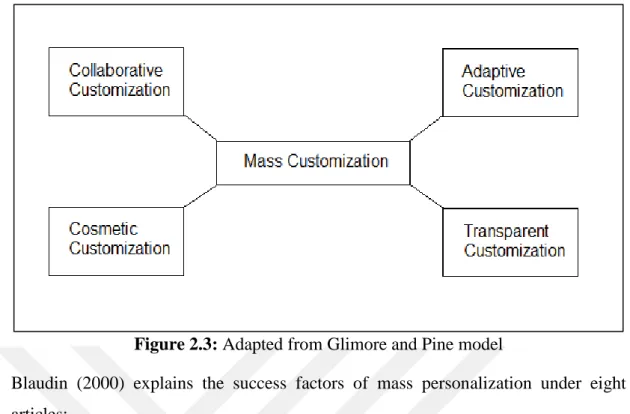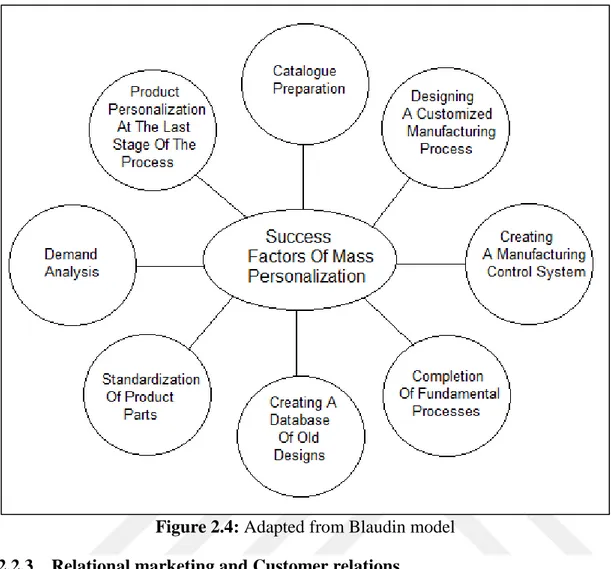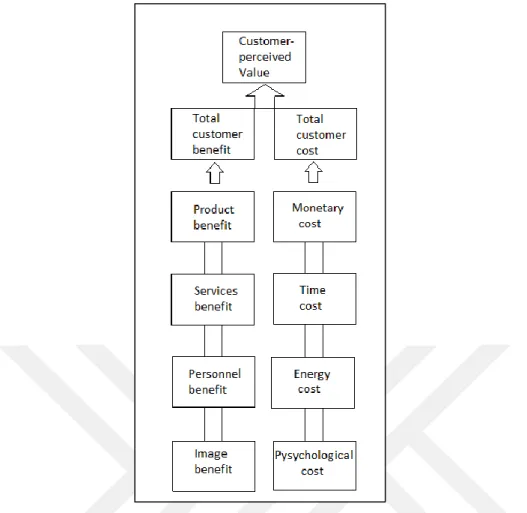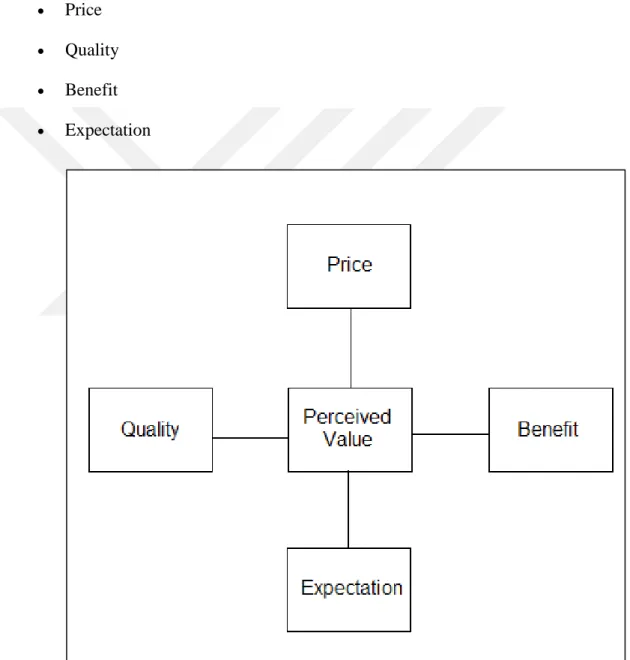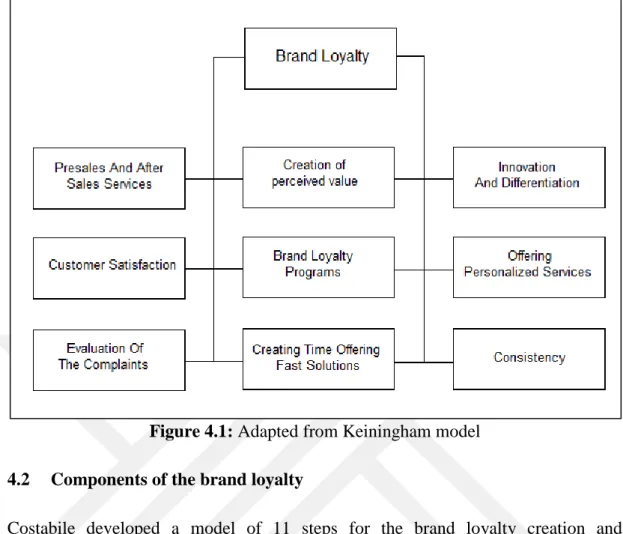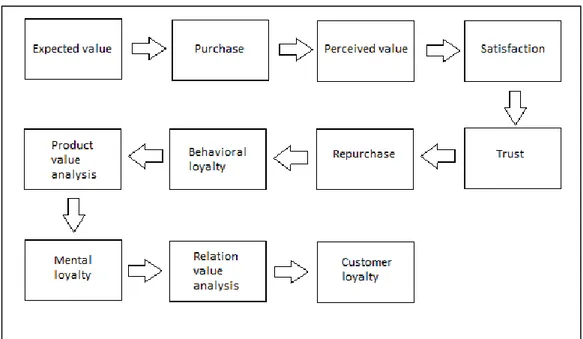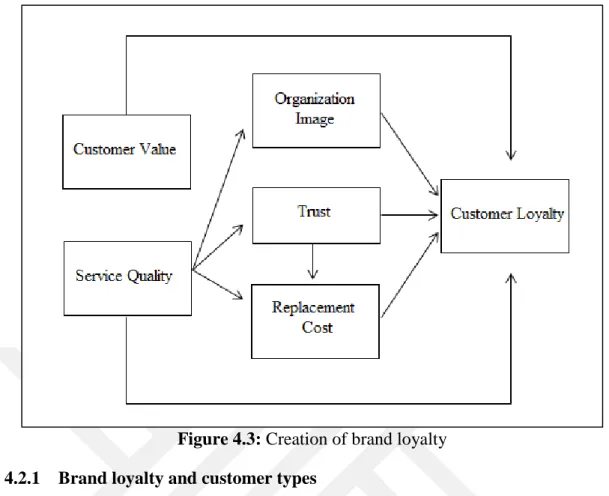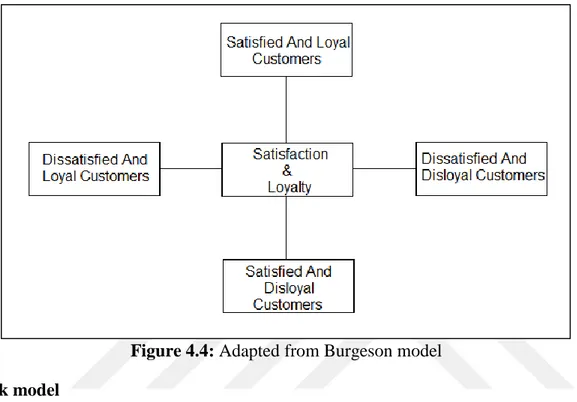T.C.
ISTANBUL AYDIN UNIVERSITY INSTITUTE OF SOCIAL SCIENCES
THE EFFECT OF PERSONALIZED CUSTOMER SERVICES ON CUSTOMER PERCEIVED VALUE AND BRAND LOYALTY
MASTER THESIS
Fargol ETEZADI (Y1312.130071)
DEPARTMENT OF BUSINESS ADMINISTRATION BUSINESS MANAGEMENT PROGRAM
Thesis Supervisor: Yrd. Doç. İlkay KARADUMAN
DECLARATION
I hereby declare that this master’s thesis titled as “The Effect of Personalized Customer Services on Customer Perceived Value and Brand Loyalty” has been written by myself in accordance with the academic rules and ethical conduct. I also declare that all materials benefited in this thesis consist of the mentioned resources in the reference list. I verify all these with my honor. (20.07.2016)
FOREWORD
I would like to thank my dear advisors Asst. Prof. Dr. İlkay Karaduman and Asst. Prof. Dr. Nurgün Komşuoğlu Yılmaz for their endless support in the process of writing this thesis.
I am grateful to my loving parents Samareh Nazeri and Firouz Etezadi for standing by me through all the obstacles and helping me get to this point in my life.
Also, I’d like to thank my husband Soheil Norouzi and all my family and friends who had been supporting me all along the way.
Finally, I can’t express how much support and affection my lovely daughter Rose Norouzi has shown to me and how thankful I feel for her existence in my life, without her, I wouldn’t be able to live my life.
TABLE OF CONTENTS Page FOREWORD ... vii TABLE OF CONTENTS ... ix ABBREVIATIONS ... xi LİST OF TABLES ... xiii LİST OF FIGURES ... xv ÖZET ... xvii ABSTRACT ... xix 1 INTRODUCTION ... 1 2 CUSTOMER SERVICE ... 5
2.1 Analysis of Business Management, Marketing And Customer... 5
2.1.1 The concept of customer ... 7
2.1.1.1 Being customer-oriented ... 8
2.1.1.2 Market types and customer relations... 8
2.1.1.3 Purchasing habits of the customers ... 10
2.2 Customer Service and Personalized Strategies ... 11
2.2.1 After sales services and personalization ... 12
2.2.2 Mass Customization and personalization ... 13
2.2.3 Relational marketing and Customer relations ... 16
2.2.4 Personalized customer services ... 17
2.2.4.1 Experiential services ... 18
2.2.4.2 Relationship Marketing ... 18
2.2.4.3 Product personalization ... 21
2.2.4.4 Databases and personalized customer relations ... 22
2.2.4.5 Customer complaints ... 23
2.3 Customer Relation Management (CRM) ... 23
2.3.1 The features which CRM must possess ... 24
2.3.2 Stages of the CRM ... 25
3 CUSTOMER PERCEIVED VALUE ... 27
3.1 Scope Of The Percieved Value... 27
3.1.1 Value models ... 28
3.1.2 Perceived value by the customer features ... 29
3.1.3 Customer’s assessment of products and services ... 31
3.1.4 Perceived value and pricing ... 32
3.1.5 Creating perceived value ... 33
3.1.5.1 The importance of perceived value for a business ... 34
3.1.5.2 Customer Lifetime Value ... 35
3.1.6 The relationship between Value and Satisfaction ... 35
4 BRAND LOYALTY ... 39
4.1 The concept of brand loyalty ... 39
4.1.2 Perceived value in creation of brand loyalty ... 40
4.1.3 Service quality in creation of brand loyalty ... 41
4.1.4 Applications related to the brand loyalty ... 42
4.2 Components of the brand loyalty ... 43
4.2.1 Brand loyalty and customer types ... 45
4.2.2 Brand Loyalty Models ... 47
4.2.3 Loyalty from the perspectives of the customer and the business ... 52
4.2.3.1 Assessment of Loyalty with Regards to the Customer ... 53
4.2.3.2 Assessment of Loyalty with Regards to the Business ... 54
4.3 Brand loyalty programs ... 55
5 RESEARCH METHODOLOGY AND FINDINGS ... 59
5.1 Research Method ... 59 5.2 Survey Analysıs ... 59 5.2.1 Demographıc Analysıs ... 60 5.2.2 Descriptive statistics ... 64 5.2.3 Regression Analysis ... 65 5.2.4 Correlation Analysis ... 72 6 CONCLUSION ... 73 REFERENCES ... 75 APPENDIX ... 83 RESUME ... 93
ABBREVIATIONS
LIST OF TABLES
Page
Table 5.1: Statistical Frequency Distribution of Demographic Variables ... 60
Table 5.2: Descriptive Statistics ... 65
Table 5.3: Regression Model Summary ... 65
Table 5.4: Anova Model for Regression Analysis ... 66
Table 5.5: Coefficients of Model for Regression Analysis ... 67
Table 5.6: Regression Model Summary ... 67
Table 5.7: Anova Model for Regression Analysis ... 68
Table 5.8: Coefficients of Model for Regression Analysis ... 68
Table 5.9: Regression Model Summary ... 69
Table 5.10: Anova Model for Regression Analysis ... 70
Table 5.11: Coefficients of Model for Regression Analysis ... 71
LIST OF FIGURES
Page
Figure 2.1: Adapted from Rolf Engsig model... 9
Figure 2.2: Keller and Kotler Marketing Funnel (2012). ... 11
Figure 2.3: Adapted from Glimore and Pine model... 15
Figure 2.4: Adapted from Blaudin model ... 16
Figure 2.5: Adapted from Alagöz et al. model ... 26
Figure 3.1: Determinants of Customer-Perceived Value ... 28
Figure 3.2: Adapted from Zeithaml model ... 29
Figure 3.3: Adapted from Oyman and Odabaşı model ... 30
Figure 3.4: Müşterilerin Hizmet Kalitesini Değerlendirmesi ... 32
Figure 4.1: Adapted from Keiningham model ... 43
Figure 4.2: Levels and Stages of the Brand Loyalty (Costabile, 2000). ... 44
Figure 4.3: Creation of brand loyalty ... 45
Figure 4.4: Adapted from Burgeson model ... 46
Figure 4.5: Adapted from Tek model... 47
Figure 4.6: Adapted from Uncles et al. model ... 48
Figure 4.7: Adapted from Dick and Basu model ... 49
Figure 4.8: Adapted from Goldrick and Andre model ... 51
Figure 4.9: Loyalty model of Keiningham et al. ... 52
Figure 4.10: Adapted from Keiningham et al. Model ... 54
Figure 4.11: Adapted from Butscher model... 56
Figure 4.12: Relationship between personalized customer service, customer perceived value and brand loyalty. ... 57
Figure 5.1: Age ... 61
Figure 5.2: Marital Status ... 61
Figure 5.3: Income Level ... 62
Figure 5.4: Gender ... 63
Figure 5.5: Educational Level ... 63
MÜŞTERİ HİZMETLERİNİN MÜŞTERİ ALGI DEĞERİNE VE MARKA SADAKATİNE ETKİSİ
ÖZET
Müşterinin algıladığı değer, müşterinin belirli bir ürüne ve hizmette karşı düşünce ve davranışları ile ilgili iken, müşteri algısı ürün ya da hizmette fiyat, kalite veya marka imajı gibi özelliklerie göre şekillenmektedir. Öte yandan marka sadakati müşterinin belli bir markaya karşı geliştirdiği algıya ve tatmin derecesine göre gelişmektedir. Bu çalışmada kişiselleştirilmiş müşteri hizmetlerinin müşteri algı değeri vasıtasıyla marka sadakatine etkisi incelenmektedir. Bu araştırma raporunda müşteri algı değeri ve marka sadakatinin önemini kuramsal olarak irdeleyebilmek için ayrıntılı literatür taramasına yer verilmiştir. Öte yandan müşteri hizmetlerinin major elemanlarından olan kişiselleştirilmiş müşteri hizmetleri, müşteri algı değeri ve marka sadakatinin önem ve kapsamı da aynı şekilde incelenmiştir. Jean Noel Kapferer, Milton Freidman, David Allen Aaker ve birçok bilim insanının metodları çalışma boyunca destekleyici unsurlar olarak kullanılmıştır. Literatür taramasından yola çıkarak çalışma sonunda kavramsal bir çerçeve oluşturulmuş ve üç ayrı hipotez major verilerin ilişkisini incelemek adına bu çerçeveye dayandırılmıştır. Kuantatif bir araştırma yöntemi olarak bir anket hazırlanmış ve SPSS analizinin uygulanması ile farklı istatistik testler olan korelasyon ve regresyon modelleri çıkarılmıştır. Bu yöntemler ve verilerin toplanması sonucunda kişiselleştirilmiş müşteri hizmetleri, marka sadakati ve müşteri algı değeri arasında pozitif bir ilişki olduğu gözlemlenmiştir.
THE EFFECT OF PERSONALIZED CUSTOMER SERVICES ON CUSTOMER PERCIEVED VALUE AND BRAND LOYALTY
ABSTRACT
Customer perceived value is all about customer thinking and behavior towards specific product or service while customer perception is established according to different feature of product or service such as quality, price or image of brand. However, brand loyalty is created by satisfying the customer needs as per their perception about specific brand. This research studies the effect of personalized customer services on brand loyalty with a moderating effect of customer perceived value. In the research report, a detail literature review is conducted to discuss the theoretical facts about customer perceived value and importance of brand loyalty. Then the importance and scope of customer service is also examined by focusing on major variables which are personalized customer service, brand loyalty and perceive value. Jean Noel Kapferer, Milton Freidman, David Allen Aaker and many other scientists’ methods are used throughout the thesis to support research assumptions. Based on literature review, conceptual frameworks is developed and three different hypotheses are established to test the relationship among major variables. A quantitative research approach is used and primary data is collected by conducting a survey. The collected data is analyzed in SPSS by applying different statistical tests such as correlation and regression model. Research findings of the report indicates that there is positive relationship among personalized customer service and brand loyalty. Moreover, the moderating effect of customer perceived value on that relationship is also observed.
1 INTRODUCTION
The fundamentals of business management are making profit while satisfying the people’s need of goods and services. The fast-growing economy forces businesses to find new ways to keep up with it. The focus of these methods is the customer satisfaction. A business cannot be successful without prior approval of their products and services by customers. Companies use different techniques to increase customer satisfaction. In the first chapter of this report, customer service is discussed in detail by focusing on its different aspects. Mainly, to run a business organization needs a proper business unit to create products and services, a marketing department to promote these products and services whereas last and important things is customer who buy these products and services. Organization cannot generate any revenue without interest of their customers, so for a business “Customer is everything”. Moreover, the competition among organization have been increased due to globalization and advanced use of technology. Now, there are many ways of promotion and advertising to attract customers. However, with great technology there comes a great responsibility to use that technology efficient to get better output.
One most important concept discussed in chapter one is being customer oriented which indicates that organization should develop proper strategies to retain their customers by satisfying their needs. The customer satisfaction also increases their loyalty towards specific brands which enhance their tendency to buy their product more than once. However, organization has to manage their customer relationship according to different market types. In chapter one of this report, four major types of market segmented, personalized and private markets are discussed in detail. Moreover, Kotler’s Marketing Funnel is adopted to discuss the purchasing habits of customers which include seven steps starting from target market to brand loyalty which is final stage of customer satisfaction. A personalized customer service is also an important strategy adopted by organization to manage their relationship with customers. In personalized marketing, customers are treated individually by using advanced technology such as social media marketing. Organization manages their
customers very carefully in personalized marketing as they conduct both pre-sale and post-sale services. Mass customization is a type of personalized marketing, where customers are differentiated based on their collective taste and interest. In this way, organization can create a specific promotion tool to target that personalized group. Mass customization technique can also be used for product personalization which helps to create a certain product for specific group of people. Personalized customer service is one of the most effective marketing strategy. This technique makes the customer feel special. This makes the customers commit to the company and prevents them from working with other companies. This way the company reduces their risks of losing their old customers while gaining new customers by increasing customer satisfaction. In addition, satisfaction of the customers in terms of communication with customers helps to get feedback on their satisfaction, complaints and requests. Securing customer satisfaction helps the companies spread to wider audiences which is the main method of brand awareness.
Customer perception about specific product or services is also important for success of a brand. Due to large availability of products and services in market, customer analyzes these products and services based on their self-defined area which is called perceived value. In order to understand the customer perceived values effectively, theoretical work of Kotler on perceived value is utilized in chapter two of report. Moreover, concept of value is also discussed by focusing on three different categories which are consumption value, perceived value and customer value. It has been observed that customer consider brand image, quality and price of product while making perception about a product. Development of customer perception needs a whole process which starts from brand awareness and ends at building a long term relation with a loyal client. Perceived value of customer about a specific products can also limit their satisfaction level, as perceived value relates to the expectation of customer from a specific product or service while satisfaction is successful achievement of these expectations.
One of the important advantage of customer satisfaction is that it creates brand loyalty which builds the trend of repeat purchase and increases business profit. Moreover, customer perceived value of a product or service is also significant for creation of brand loyalty. In chapter 3 of the report this assumption is discussed in detail by considering different features of brand loyalty such as service quality,
customer type and components of brand loyalty. There are eleven stages involves in creation of brand loyalty which started from expected value and ends at relation value analysis. Moreover, different models of brand loyalty is also discussed in chapter two of research report such as Tek model, Burgeson model, Uncles et al. model, Dick and Basu model, McGoldrick and Andre etc. Brand loyalty is also assessed by focusing on different aspects such as customer loyalty, business loyalty and brand loyalty program.
After reviewing the existing literature on the subject matter, conceptual framework is developed. Three major variables, personalized customer service, customer perceived value and brand loyalty are identified. Personalized customer service strategy bonds the company with the customer and affects the brand loyalty positively. The proposed theories stem from previous literatures and researches. The research includes personalized customer service that results with brand loyalty and customer perceived value. Therefore, it has been assumed that there is a positive relationship among personalized customer service and brand loyalty which is moderated by customer perceived value. The main objective of the research is to develop different hypothesis based on that assumed relationship and test of the effect of personalized customer service on customer perceived value and brand loyalty by using statistical test.
In order to test hypotheses of study, a systematic approach is used which involves collection of primary data by conducting a survey from “50” people. A structured questionnaire is used as a research instrument to collect data from respondents. Questionnaire is divided into three parts, first part includes question related to personalized customer service, second part is about customer perceived value and third part asses the respondents view about brand loyalty. Likert scale is used for development of questionnaire which involves five steps strongly agree to strongly disagree. Chapter four of this report discuss the research methodology and findings of the research study in detail. SPSS is used to analyze the collected data by using different statistical tests such as correlation and regression. Chapter five of report concludes the overall findings of data which includes both theoretical finding and statistical findings.
2 CUSTOMER SERVICE
2.1 Analysis of Business Management, Marketing And Customer
Business administration, in general, is the economic unit creating products and services in order to meet the needs of others and to generate profit for the business owner. Alfred Isaac defines the business as the sum of units conducting manufacturing processes and providing for the needs of the consumer in a direct or indirect manner (Mucuk, 2012). As the business is an important part of a nation’s economy it is critical for that nation. Therefore, business management, which makes it possible for a business to achieve success evaluating the relevant factors and trends, is necessary for a business to flourish and to move forward. Since the industrial revolution, businesses have been looking out for different approaches in order to keep their competitive edge in the face of increasing number of businesses and product variety. Considering a company’s competitors are targeting the same customer base in an industry, being different form the others is the motive to prefer a brand for the customer (Mucuk, 2012). In this context, being customer-oriented will be one of the fundamental factors to make a difference.
The sense of customer satisfaction while generating profits rather than only generating profits in any way possible has gained importance in the US and gained widespread recognition in the world since 1950s. Nevertheless, market analysis has been shaping the manufacturing with product planning and development efforts putting the customer in the center rather than merely trying to sell products since 1960s. After sale services have gained importance in the marketing approach with long-term profit and continuous sales policies and developing countries are now trying to implement this approach (Nurettin, 2010). Briefly, customer-oriented era has begun leading to reorganization of a marketing department working in coordination with the other segments of a business. However, according to this approach, not only the marketing department but also the other segments of a business must adapt to being customer-oriented and must evaluate factors such as design, price, distribution, etc. considering the customer (Bilge et al.). Accordingly,
products and services must be able to meet the needs of people and consumers must be able to benefit from the customer-business relationship.
As a result of the globalization, businesses are now setting their goals in a way to make it possible for them to generate profit, to generate sales profits, to survive and to grow (the most important goal of a business is to overcome the obstacles posing a threat to its existence and to keep up with the changing environment) which will allow them to exist in the competition and further their business. Therefore, it will be possible to bring consistence to the management functions such as planning, organization, management, coordination, and auditing (Mucuk, 2012). It is important to note that quantitative and qualitative criteria are considered when determining the size of a business (Güneçıkan, 2008). Businesses make efforts to survive while trying to grow in the face of these criteria. However, it would be fair to say that small businesses are more advantageous than big businesses with regards to the attention paid to the customer. As small businesses target a limited customer base, they are able to be in close contact with the customer and able to create personalized relations. This brings the small businesses the advantage in terms of customer relations and better services (application for small business,2015). Targeting a wider customer base and having a greater distance from the customer, big businesses struggle to obtain this advantage. With the increasing number of customers, reducing opportunities to become familiar with the customer and decreasing attention a customer gets have become disadvantages of big businesses. It will be best for a big business to enjoy the benefits of its size while trying to gain the competitive advantage of being able to generate better and personalized services for the customers, which is commonly the case for small businesses. Customer relations comes into play at this point and aspects such as the amity of personalized sales method, communication, being welcoming, listening to the customer, finding solutions and gathering information need to be attended.
R&D operations of businesses have gained momentum with the globalization. R&D focuses on innovative design and manufacturing and attempts to generate innovations and make difference in line with the customer expectations and demands (thalesgroup). The purpose of R&D in connection with the consumer can be broken down to satisfying customers who expect difference. With such customer-oriented
features, R&D is one of the most important units of a business which defines its competitiveness.
2.1.1 The concept of customer
Considering the fact that a business is meaningless without customers, the definition of customer must be recognized and evaluated to the fullest by a business. Overall, customer is a person or an establishment which purchases products and services from a business in order to satisfy its needs and demands and which has the purchasing power to do so (businessdictionary.com). According to another definition of customer is a person or an establishment which purchases a specific product of a business for commercial or personal purposes (Taşkın, 2005). Briefly, customer is the person who purchases products or services in order to satisfy his/her needs and demands.
Marketing approach has been changing with the increasing competition and changing environment. Traditional marketing is merely sales-oriented, product specifications are important, long-term sales strategy is disregarded, an average customer relation is available and customer satisfaction is not emphasized. Modern marketing approach, on the other hand, emphasizes customer and customer satisfaction as its top priority; returning customers and long-term relations are of utmost importance (Anbastassova, 2013). Now it is not only about sales but also about satisfying customer needs and providing satisfaction to the customers while doing so. This kind of a change had an impact on the approach to the concept of customer and emphasized the customer satisfaction. Satisfaction is effective in guiding customer behaviors such as recommending the brand to another customer, repurchasing the product, etc. Nevertheless, employee satisfaction also affects customer satisfaction in a business (Cronin et al., 2000). Therefore, a business needs to place importance on its employees as well as its customers. In other words, internal customer satisfaction will have an impact on the customer satisfaction as the customer satisfaction depends on the behavior and performance of internal customer (Taşkın, 2005). Shortly, it would be fair to say that the success of a business depends on being human-oriented. Internal customer is a company’s employees while the external customer is the consumer. The satisfaction of internal customer reflects on the external customer who seeks attention, amity and solutions. Therefore, a business needs to create a
satisfied internal customer when providing customer satisfaction. Generally, internal customer satisfaction is easier to obtain than external customer satisfaction. Given the opportunity to initiate discussions and exchange of ideas with internal customers, it is easier to define the needs and demands of internal customers when compared to the external customers (Şimşek, 2006).
2.1.1.1 Being customer-oriented
Being customer-oriented is about developing strategies for retaining customers, building long-term relations with them and increasing their buying tendency instead of finding new customers and making a single sales (udybelgesi). According to another definition, it is a strategy for building long-term relations, providing quality products and services and making a difference by creating a dialog instead of a monolog (Yılmaz et al.). Thus, it will be beneficial to offer quality products and services, to keep good relations, to initiate reciprocal communication, and to create different values. Customer-oriented businesses do not aim for merely making sales or generating one-sided profits. It aims to have customers feel beneficial and to provide satisfaction and customer loyalty is possible in this manner (Dalay, 2013). Customer-oriented businesses place utmost importance on the customer and customer satisfaction and they develop their strategies accordingly. Philip Kotler and Keller explain their customer-oriented strategy as trying to get to know the customer closely, to provide guarantee and software-hardware services along with fast and differentiated services, to offer alternative services while making the shopping experience enjoyable for the customer, to created loyal customers with loyalty programs, and to capture customer satisfaction ensuring the employee satisfaction (2006).
2.1.1.2 Market types and customer relations
Marketing process involves the business and the customer. The business aims to maximize its profits reducing its costs, while marketing aims to provide customer satisfaction. Every business has a different marketing approach and perception for configuring, guiding and furthering its operations. As a result, each business is able to produce different outcomes from their customer relations. The importance place on the customer has a direct impact on the customer-business relation (Berrin, 1999). In this context, Engsig has evaluated market types in four categories (Engsig, 1997):
Figure 2.1: Adapted from Rolf Engsig model.
Segmented markets: These are the markets devoted to fundamental needs of customers and here customers are divided into groups by their demands and purchasing behaviors. As customers most commonly show the same purchasing pattern for each purchasing experience, quantity and quality are important at the same level in this market. Here, business and customer relation is built in segments and the existence of such a relation becomes apparent.
Personalized markets: This type of markets is built according to personal demands and it is the market type which involves the highest level of customer relations. Customers are offered a variety of options for purchasing. This market emphasizes quality rather than quantity. The main purpose of the business is to be customer-oriented. Accordingly, businesses adjust their products and services in respect to the customer.
Mass markets: It is a market type built on the quantity in which customers have similar expectations. In this respect, the main purpose is to increase the production due to the lack of products and services and to maximize the profits. There is no special relation between customers and businesses in the mass market.
Private markets: However, these markets are built on the personal demands, these demands are above personal needs and involve demands such as production and research methods. It is a market type in which both the quality of product and the manufacturer is important. Being environmentally-friendly is emphasized in this type of marketing and it is expected to adopt a policy which puts the society in the center. The business-customer relation focuses on environment and society rather than the interest of the parties.
2.1.1.3 Purchasing habits of the customers
Kotler’s “Marketing Funnel” shows the steps of purchasing habits of the customer. This funnel represents the process starting from a customer hearing about a brand to being introduced to the brand and brand loyalty to be created. It also emphasizes the importance of marketing strategies. The business initiates the marketing process with brand recognition using elements such as advertisement. The next step of the funnel is the one in which customers purchase the brand once and this customer behavior is continued as long as the customer faces no problems with the purchase. And as long as customer satisfaction is realized with the increasing number of purchases the customer becomes loyal to the brand. Factors and methods such as customer relations and marketing lead customer to be introduced to the brand, to build a relation with the company, to further this relation and to become loyal to the company.
Figure 2.2: Keller and Kotler Marketing Funnel (2012). 2.2 Customer Service and Personalized Strategies
Customer services involve not only presales services but also the after sale services. After sale services play an important role in the product and brand perception of the customer (Aile ve Tüketici Hizmetleri, 2011). The service usually initiates with the communication between the customer and the personnel. This potential starts with the customer’s sales tendency, then continues during the purchase and is reinforced with after sales services (business.qld.gov.au). Different factors are in place changing from one customer to another when satisfaction is in question. The reason behind this is that customer perception evaluates the quality and accordingly provides the satisfaction. However, perception differs from person to person. According to Oliver, satisfaction is realized based on the customer expectations and demands (Oliver, 1997). It might be said that customer defines the quality based on his/her expectations. Customer is discontent when his/her expectations are not met while he/she is satisfied when his/her expectations are met. Recently, strategies aiming to make the customer feel special are applied along with being customer-oriented. In this context, businesses follow strategies to personalize the transactions and this kind of a personalization leads to even reinforced customer loyalty (Keller & Kotler, 2012). After sales services are differentiated while modern marketing strategies are adopted in order to allow for personalization application in customer services.
2.2.1 After sales services and personalization
After sales services, in general, can be summed up as services offered by the business to the customer for his/her convenience which include technical support for a product and a service; guarantee, maintenance, delivery, customer services via phone, and online services. After sales services play an important role in the customer loyalty. A company needs to have a good CRM for good after sales services. After sales services play an important role in the fulfillment of customer expectations and therefore customer satisfaction. It is also very important in the way to retain the customer and reinforces the communication between the customer and the business (Irini, 2008). Nevertheless, databases play a significant role in increasing the customer satisfaction providing information about the customer which makes it possible to treat customers in an individual level (Kelley, 2000). It takes providing convenience to the customers and to make them feel special in order to improve customer satisfaction. Businesses commonly take heed of the following criteria for the satisfaction from after sales services (eticaretmag.com):
Paying attention to positive and negative feedback and use them for development and improvement. Building a system for this purpose. Recognizing and making up for situations in which the company was
amiss.
Listening to the customer and producing solutions. Minding the complaints and identifying shortfalls
Training the personnel for a caring and customer-oriented team
Being available. Customers must be able to reach the company easily for support or for expressing their opinions.
Having a decent technical support team. Being in touch with the customer
Making use of the time well. Creating solutions in a rapid manner and not making the customer wait.
Businesses which pay attention to these criteria will satisfy the customer. Satisfaction, in exchange, triggers the will of the customer to repurchase (Taylor & Baker, 1994). We can take a bank customer for example. First of all, online and phone services as after sales services are expected from banks in today’s world.
Being able to follow up with customers using databases and making customer information readily available when a customer gets in touch can be evaluated as part of the personalized service concept. A customer representative who addresses the customer with his/her name and the representative’s attitude will definitely affect a customer’s opinion about the bank. Listening to complaints, feedback and demands of customers, if any, and offering fast solutions will affect a customer’s opinion about the bank. A customer who is welcomed with a nice attitude, who is treated in a personalized manner as his/her information is readily available and who feels that his/her opinion counts will develop a perception value and this will turn into customer loyalty in time. However, the total opposite, a business which does not care about who the customer is, which is not familiar with customer’s demands and expectation will be subject to the risk of losing that customer. Therefore, however much the customer feels important in after sales services, the customer satisfaction increases. And this is possible with personalization strategies.
2.2.2 Mass Customization and personalization
In a world in which options are abundant and competition is ever increasing, customers may not be retained if the business falls short on meeting the needs, demands and expectations of the customer. Thus, a business which is not able to meet the expectations will suffer customer attrition. Considering finding new customers and building customer loyalty is more costly than retaining the customers, customer attrition is an important issue for the business. Customer attrition is also an impairment of the company image. In order to avoid such situations, a business must find strategies to revive the relationship with its customers and apply these strategies in order to survive in a competitive market. One of these strategies is mass customization (Midilli). Mass customization is a method used as part of personalized services. Mass customization calls for customer-specific, differentiated values and customized mass production methods with reduced costs which are in line with the customer demands and expectation.
Gilmore and Pine, define mass customization in four categories in 1997, namely, collaborative customization, adaptive customization, cosmetic customization, transparent customization:
Collaborative customization: Aims to identify and meet the needs of customers in a one-on-one communication setting with the customer. It involves personalization of end products according to demands and opinions of the customers. The assembly of a product with finished parts according to customer demands and specifications is an example of this category.
Adaptive customization: This approach makes it possible for the customer to personalize a product according to his/her preference without the need for getting in touch with the manufacturer. Technological advancements and innovative elements support this opportunity. Interchangeable models in textile industry are an example of this approach.
Cosmetic customization: It is an approach which makes it possible to reach out to increased number of customers and allows customers to personalize a product in a limited manner. Here, customer is able to change some of the features of a product. The option to change color and pattern of a clothing item on an online environment is an example of this category.
Transparent customization: Customers are not aware of the fact that the product is personalized for themselves in this approach. The business makes efforts considering the habits and taste of its customers. Ads which one can see on his/her profile page on a social network are customized in order to be appealing for the person according the user’s previous browsing history (Gilmore & Pine, 1997).
Figure 2.3: Adapted from Glimore and Pine model
Blaudin (2000) explains the success factors of mass personalization under eight articles:
1-Catalogue preparation: Reducing costs via identification of the personalization limits according to the customer needs with a catalogue prepared considering different demands of customers.
2- Product personalization at the last stage of the process: it requires a specialized effort and reduces costs as it is able to identify errors in an early stage.
3- Demand analysis: it guides the manufacturing and helps reduce the costs.
4- Standardization of product parts: assembly of previously manufactured standard product parts according to the customer demand
5- Creating a database of old designs: helps the creation of new products while saving on time for demands on products similar to the old products.
6- Completion of fundamental processes: developing standards for personalization stages beforehand as they work in a similar way.
7-Designing a customized manufacturing process: increases the yield and saves on time as what to do and how to do it is known.
8- Creating a manufacturing control system. Helps with planning and timing. It reduces the errors (Blaudin, 2000).
Figure 2.4: Adapted from Blaudin model 2.2.3 Relational marketing and Customer relations
Marketing is basically an exchange transaction which provides for the needs and demands. It is realized when parties involved communicate each other and each one of them believes that they benefit from this transaction (Mucuk 2012). Relational marketing, on the other hand, is not only about the exchange transaction differing from the traditional marketing. It involves initiatives which meet the needs of the customer. Customers are evaluated as individuals and according to Dick Bucci this approach increases the customer loyalty resulting in a loyalty connection (Bucci). Customers who feel being treated as individuals tend to build bonds quickly in a way to affect customer loyalty. Customer relations and the relation built between customer and the business are important for relational marketing. This kind of a relation has a positive impact on the long-term profits of a company. Communication makes it possible to have information about the customer therefore company can recognize the customer. As a result, a business which is aware of the needs and demands of the customer has the chance to offer better services to the customer.
Satisfied and loyal customers usually prefer this business and they do not tend to go for the others.
2.2.4 Personalized customer services
In personalized customer service, the customer is treated as an individual and everything associated with customer are handled very smoothly by the organization. However, anything that goes past the client relationship ought to be dealt with as personal data. Therefore, the main focus of personalized customer service is to give respect and pay attention to customer need not to spy his personal information. The customer became more loyal as their level of satisfaction increased because they are treated as individual. Loyal customers are beneficial for every business as they purchase more, buy all the more regularly, cost less to serve, and have higher consistency standards (Buell, Campbell & Frei, 2010).
According to Peppers and Rogers (2004), there is a special association among customers and service providers, and that association can be straightforward and simple, or emotional and complicated. The main differentiator among various organization is their customer services, however due to increase in communication channel organization are facing numerous chllanges to deliver personalized customer service. For example, communication can be customized through letters, website connections, regular postal mail, other machine-intervened collaborations, and email. Moreover, service personnel also offer in-person correspondence before and after the purchase of products (Ball, Coelho & Vilares, 2006).
The advancement in technology along with economic and social forces are motivation the demand of personal customer services which can be conveyed more rapidly. Moreover, customers have the right to choose communication channel for personalized services based on their preferences (Ball et al, 2006). In today’s market, the top priority of every organization is to improve customer care and level of customer satisfaction such as they are appointing the administrators with titles as Chief Customer Officer. In order to enhance the consumer satisfaction and customer retention, organizations need to improve the client involvement. Therefore, they try to adjust the expense of giving quality service with the insistent business target of controlling costs (Buell et al., 2010).
2.2.4.1 Experiential services
In case of experiential services, the main focus of an organization is on customer experience during any extractions rather than emphasizing on functional benefits of services provided. Customer experience is traditionally focused more in organization which are operating in entertainment and leisure businesses, because a good experience is the main thing they can offer to customers, such as cinemas, amusement parts, skiing etc. On the other hand, experience can be described as every touch which a consumer has with the administrations, regardless of how unremarkable the service that is being conveyed. There are different levels of customer experiences as it can be less or more memorable based on their features (Carbone and Haeckel, 1994).
Recently, customer experiences have become the main focus of many organization as they can differentiate themselves from competitors by managing customer experience effectively. Moreover, the efficient designing of customer experience in an organization can improve their service levels quickly (Pine and Gilmore, 1998). The customer loyalty can also be influence by quality of experiences, as when customers have good experience with an organization they like to comeback for repeat purchase and also spread good word of mouth among their friends. According to Pullman and Gross (2004), experience designing is a method to deal with emotional side of customers which can create a long term connection through careful arrangement of intangible and tangible actions.
2.2.4.2 Relationship Marketing
A procedure of classifying, evolving, sustaining, and ending social trades with the main objective of increasing organization performance is called relationship marketing. The basic reason behind relationship marketing is that there is a need of constant and focused attention towards vital customers of organization. The core definition of marketing is carefully focused in relationship marketing, as the main objective of marketing is to create, retain, improve and commercialize client connections, as both parties stayed satisfied with business process (Gummesson, 2011). Therefore, relationship marketing is based on the execution and mutual exchange of promises to get different things for satisfaction of both parties.
Mainly, these are some major aspects which are focused on relationship marketing such as its focal point is to coordinate market orientation with customer services. Moreover, it emphasized on creating new customers and retaining old ones, as the concept of total quality is followed in relationship marketing where an efficient association amongst firm and its clients, suppliers and key markets are managed on a progressing premise (Hollensen, 2015). Customers have a large number of choices when they go out for buying a product or service, so it is difficult for them to make choices based on limited knowledge. Therefore, service quality is their focus while making a purchase decision and perceive about products. The organization needs to realize how to increase value and satisfy their customer, and for this purpose they need relationship marketing (Gummesson, 2011).
Mass customization of services
According to Piller and Müller (2004), mass customization can be described based on three options as
1: Differentiation Option
Mass customization implies the creation of products and service for a moderately big business sector, which address precisely the issues of every individual client with respect to product features.
2: Cost option
Mass customization at cost generally relating to those of standard mass-delivered products as this option is not viable where cost is less of a factor.
3: Relationship option
The data gathered amid the procedure of individualization serves to develop an enduring individual association with every client which can provide a way for mass customization.
Mass customization deals with customer satisfaction while making improvements in product and services by introducing new features. These improvements could be as little as an assortment of various colors or flavors, or it can be as complicated as creating a totally new item for a specific customer base. The combination of
flexibility and personalization of customized product at larger level is used in mass production which further leads towards reduction in per unit cost. In this manner, the main target of mass customization is diverse mass purchaser rather than a single customer (Tseng and Piller, 2011).
One to one services
One-to-one marketing is a customer relationship management approch with a main focus of personalized interactions among organization and customers. A personalized interaction can icrease the conusmer loyal and repeat purchase which further leads towards higher profit on marketing investment. The following are two major types of one to one marketing (Keller & Kotler, 2012).
1- Personalization: The organization learns about the customers taste and their preferences first, then used a customized marketing plan to tackle these customers.
2- Customization: The customer preferences are not learnt by the organization as the individual customers are enables to customize the goods based on their own tastes.
Permission Services
An approach to sell products and services where all necessary information are explicity provided to potentionsl customer is called permission marketing. Such as, picking a email with an option of inviting other customers who want to get more information about specific products is a type of permission marketing. According to Krishnamurthy (2001), permission marketing is most effective marketing approach where customer can be more responsive because they have early interest in specific product and they can make purchase decision easily after knowing its price and other fearture. The idea of permistion marketing is welcomed by many customer in today’s world of automated telemarketing, extensive information, and spam as make purchase decision easy. Any membership to a SMS, pamphlet, RSS channel, blogs and loyalty cards are main ways of permission market such as when clients buy a Starbucks card may enroll the card on the web, which permits them to check the parity of their card, or even get a substitution if their card is lost.
2.2.4.3 Product personalization
Marketing techniques are ever changing with the advanced technology and passing time. The manufacturing style which did not consider customers as individuals was the mass production. However, following this method is easier for the business, the increasing competition resulted in a drive to provide customer-specific services. After its first appearance as Customization, businesses have soon turned towards a new trend, namely Personalization. Personalization is a rather new marketing strategy. Personalization and customization are two separate concepts. In customization, the business collects information about the potential customers and manufactures in order to meet the needs and demands of the customers (Yüksel, 1999). In personalization, on the other hand, the business learns about the needs and demands of the customer through a special connection and manufactures customer-specific products accordingly (Pine et al., 1997). It can be said that customer designs what he/she wants by himself/herself. Tailor-made gifts, custom cards are examples of this practice.
Custom manufacturing gains importance in personalization. It makes it possible for the customer to design the products for their taste. For example, Heinz ketchup bottles come with personalized messages on them (Keller & Kotler, 2012). Products with the person’s name written on such as glasses, bags, and wallets are some of the examples. The Amazon website personalizes children’s books using the information about the children and customizes the tales for the children.
Personalized marketing should focus on customers on an individual level and needs to attend to each customer individually (Keller & Kotler, 2012). The purpose of personalization is to treat each customer in a special way which can be considered as customer-specific manufacturing. Personalization allows for the flexibility to adapt to different needs of different customers. Services are shaped based on the customer information. And it plays an important role in the customer loyalty. However, it takes a strong relationship and communication between the business and the customers. The business must be familiar with the customer and must have the required information. Databases come into play in this stage. Databases make it possible for customer-specific production (Yüksel, 1999).
2.2.4.4 Databases and personalized customer relations
Marketing based on databases plays an important role in mass personalization. Customer information collected using technology helps guide the strategies adopted by the businesses. Connecting with the customer on a personal level, familiarizing with the customer, and analyzing the target market in a more efficient manner will assist in building a stronger bond with the customer (Manager UpDate,1991).
It used to be hard to collect the information when compared to our modern time and advanced technology made it possible for us to reach information conveniently. Businesses collect and store information about customers in order to be used in the future. Databases assist in the determination of customer needs, demands and expectation allowing for the collection of up-to-date information. According to Neff, businesses collect information on the customer and this information grows to be used in order to build a better connection with the customer. Therefore, the relationship with the customer can be a long-term one (Neff, 2009). It is in a way a measuring and evaluating mechanism for the business.
Therefore, this information must be updated frequently and the employees must be trained for this purpose and the business must innovate according to this information. Databases offer a collection of data collected from any sources which make it possible to reach at customers. Several channels such as online services and call centers make it possible for the company to collect information about its customers. A business can use online searches and online purchases of customers to identify the purchasing habits of its customers (Wikipedia). It is possible to collect data while finding new customers and the business tries to win these new customers. The business uses videos, texts, and pictures which are compatible with the interests of the customer in the online environment in order to attract customers and to advertise. Customer is offered a customized interface as websites are personalized in this manner. An example of this is the Facebook ads which are suitable for the interests of the user. Shopping websites, on the other hand, send emails about products which may attract their customers and boost their sales. It is easier to offer personalized customer services as the database grows and the customer information builds up and the quality increases. However, an important issue is the privacy of the customer which may have an adverse impact on the customer trust. In general, collecting data
about the customers and using this data in order to provide customer-specific production bring competitive advantage to the business.
2.2.4.5 Customer complaints
Companies are turning to market surveys in order to be able to offer better services. Market research involves collection, analysis and interpretation of the marketing opportunities and issues in an objective manner. Market research is a scientific method and it offers solutions. Surveys, observations and tests are common methods used in market research (Ventura). These methods, when considered in a customer-centric perspective, examine the complaints and demands of the customer and take customer opinions into account. Use of customer complaints as a method to improve business is important for long-term relations with the customers. In this context, issues which result in customer dissatisfaction are resolved and drawbacks of the services are removed. Customer attrition is an issue when the complaints go unresolved. Therefore, customer complaints need to be regarded as important as the demands and expectations of customers. ‘’Your most unhappy customers are your greatest source of learning’’ said Bill Gates (Ekaterina Walter). A business which follows up on the customer dissatisfaction is able to take steps to provide customer satisfaction and to improve its operations. As a result, a complaint can be transformed into positive outcomes for a business. Customers feel their opinion matters when their complaint is attended to and it provides information about the sensitive issues for customers which is an opportunity to provide customer-specific services.
2.3 Customer Relation Management (CRM)
A customer is a person who turns to a business in order to meet his/her commercial needs and demands using that company’s products and services (Taşkın, 2005). Customers, in the last decades, have been taken for a group of people and the aim was to sell products to customers. However, being customer-oriented has become more and more important with the changing market approach. Costumer relation management (CRM) is a competitive strategy which takes being customer-oriented as its core value (Bozgeyik, 2005). A good CRM conducts its production process according to the demands of its customer and offers after sales services. CRM has
gained importance in Western countries since 1980s, while it has become available in Turkey only in 1990s (Yurdakul).
The purpose of CRM is customer satisfaction. Using the developments for customer satisfaction, outpacing the competitors, offering fast services and providing differentiated products are parts of the CRM (Odabaşı, 2000). The purpose of customer relations is to build long-term relations with customers through building trust in order to focus on the long-term profits. Briefly, CRM is a strategy which is customer-oriented, which involves presales, sales, and potential sales processes along with after sales services and is now considered a necessity in the face of the increasing competition (İTO yayınları, 2009).
Being customer-oriented is one of the most crucial criteria of the mission of a business in terms of CRM. This criterion must be adopted by the business as a strategy and customers must be attended in order for long-term profits (Ersoy, 2002). It is important to know that communication with the customers is critical for the CRM to be applied correctly. It is also useful to conduct research about customers, to evaluate the satisfaction level of the customer with observations and surveys, to understand their demands and to offer better services evaluating the feedback received from the customers. In the light of the information gathered from these practices customer demands will be identified and changing trends in these demands will be met. Thus, the customer will not look for other businesses for their changing demands (Akça). In other words, the ability to build a close relationship with the customer is indicative of the success rate of a business.
2.3.1 The features which CRM must possess
According to Kırım, profiting from the relations with customers, being different than the other businesses, meeting the demands and needs of the customers while reducing costs and increasing the performance is are the main goals of CRM (Kırım, 2001). Accordingly, the relationship built with the customer and meeting the needs and demands of the customer results in returns for the business in the long term and increases the performance via brand differentiation. All of these factors allow for customer loyalty and make it possible to retain the customers therefore reducing the costs and also determine the success of the business (Taşkın, 2004).
This strategy and being customer-oriented must be adopted by the management before all the other departments for a successful CRM. Then, the customer must be familiarized with and a connection must be built. Strategies serving for this purpose must be developed for better service output and employees must be trained for a good CRM which might also involve incentives. The strategy must be furthered and the business should attempt to develop itself for all times (Demirbağ, 2004).
2.3.2 Stages of the CRM
Segmentation is made with CRM. Accordingly, the most loyal customers are identified and it is determined that which customer can contribute more and which customer brings more profit. Four stages are involved in the process of creating customer loyalty and process such as customer selection, winning customers, retaining customers and deepening customer relationships (Alagöz et al., 2004).
Customer selection: Defining the purposes of the business, offering customer-specific services in marketing formats and understanding the customer needs are fundamental elements of this stage.
Winning customers: This stage involves the requirements of CRM and a department is created to be dedicated to customer relations. A CRM team is built.
Retaining customers: Tasks are defined and priorities and product selection criteria are specified in order to define what needs to be done within a system that is created around these tasks.
Deepening customer relationship: It involves defining the process and planning the stages of this process. Experienced implementers define and design the CRM initiation process and specify what needs to be done anticipating the possible outcomes (Demir & Kırdar).
Figure 2.5: Adapted from Alagöz et al. model
According to this setup, customer is in the center and the relationship with the customer is furthered based on a strategy created beforehand. Nevertheless, databases and the help of technological advances will play an important role in the communication with the customer. Recognizing the customer will allow the business to identify the needs and expectations of the customer and offering services accordingly. It will also be easier for the business to improve, innovate and differentiate in line with the customer demands.
3 CUSTOMER PERCEIVED VALUE
3.1 Scope Of The Percieved Value
According to Flint, perceived value is a person’s criterization of a situation according to his/her values before making a personal decision. And these criteria are a behavioral reflection of people’s desires (Flint et al., 1997). According to Doyle, there are different ways to create value in marketing. First of all, the customer selects what he/she perceives as the best value among the brands. Another important point is that customers demand products and/or services in order to fulfill their emotional or economical needs and this kind of a fulfillment is about the value. The last criterion is about trying to build long-term relationships with customers (Dolye, 2003). According to its general definition, value is the difference between the money spent to meet one's needs and the benefit from that product or service purchased and it is more about the extent of benefit gained from a product or service than the fulfillment of needs and expectations and is a result of individual judgment (Karaca, 2003). Competition increases with the technology and growing markets along with the modes of competition. As customers look for more options to be made available for them, they ask for more, they ask for a better price and they ask for quality products (Tekin, 2005). Thus, it is getting harder for a business to satisfy its customers. As a result, companies are now looking to develop many strategies and to create value for the customers.
It will be useful to consider Kotler’s perceived value determinants in order to better understand the customer perception value. According to this table, customers are creating a value calculating what they gain when compared to what they spend:
Figure 3.1: Determinants of Customer-Perceived Value (Kotler & Keller, 2012). 3.1.1 Value models
Aydeniz and Yüksel address the concept of value in three different categories:
Consumption Value: Based on consumer behaviors, this category is experimental and it depends on the experience of the customer. Customer evaluates a product after he/she purchases the product, in other words, after the need is fulfilled, and uses his/her experience for the next purchase decision.
Perceived Value: It is about the quality and price ratio and is a comparison between the compromise made by the customer and the compromise made by the business. It is about customer’s perception and it differs from person to person.
Customer Value: It is the connection built between the business and the customer due to the perception of added value experienced by the customers for the products and services they have been using (Aydeniz & Yüksel, 2007).
3.1.2 Perceived value by the customer features
Customer value consists of tangible and intangible values which can be the sum of factors such as product, distribution, service, etc. (Van der Haar et al., 2001). Parasurman suggests that perceived quality is a personal evaluation and that it is not the real quality (Parasuraman et al., 1988). In other words, perceived quality differs from person to person. Zeithalm suggests that the customer perception value is created based on four criteria (Zeithaml, 1988):
Price
Quality
Benefit
Expectation
Figure 3.2: Adapted from Zeithaml model
According to these four criteria, price plays an important role in the creation of customer value perception. Nevertheless, customers develop a value perception according to the quality of the product and/or service they have purchased. It is
important for the development of value perception that customer finds what he/she is looking for in the product and/or service he/she purchased. Another aspect of this value is the extent of profit customer gains from this transaction analyzing what is received in exchange of what is given.
Odabaşı and Oyman state that the perceived value is determined by the product quality, service quality, price and brand image (Odabaşı & Oyman, 2002):
Figure 3.3: Adapted from Oyman and Odabaşı model
Based on the statements above, it is possible to summarize the factors which affect perceived value:
Having one’s expectations met creates a positive perception for the customer. Customers develop their perception based on the comparison between the benefit and the cost and this has an impact on the business (Anderson et al., 1993). Thus, it would be fair to say that low prices are rather successful in creating a perception value.
A company’s ability to meet its customers’ needs to a great extent influences the perception value.
It is possible to say that customer services, after sales services and the attending behavior of the company affect the perceived value.
